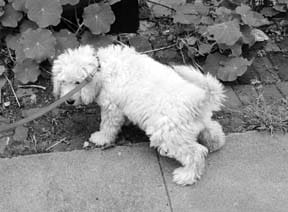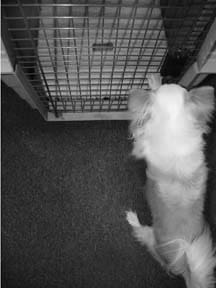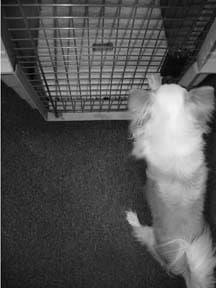The topic turned to crating on one of my trainer e-mail lists recently. I was horrified to read that some shelters and rescue groups refuse to adopt to prospective owners who intend to use a crate with their dogs. What madness is this?
I first discovered crates some 30 years ago, when they were relatively new to the dog scene. I was skeptical about putting my new Australian Kelpie puppy in a “cage,” but since Keli was part of a Canine Field Agent program for the Marin Humane Society where I worked as a Humane Officer, I was determined to do everything perfectly right. I reluctantly decided to try crating.

On the third night, when I went to deposit Keli in her crate, I found Caper, my three-year-old Bull Terrier, happily curled up in the pup’s den. Caper smiled up at me and thumped her tail in the blankets, clearly saying, “This is wonderful! Can I have one of my own? Please, can I?”
I bought Caper a crate of her own the next day, and have been a total crate advocate ever since. How could they now be perceived as a bad thing?
As I followed the discussion, I realized that the negative crate perspective stemmed from concerns of “overcrating.” Apparently some owners crate their dogs all day while they’re at work, let them out for a couple of hours when they come home, and then crate the dogs all night while everyone is sleeping. This, some shelters fear, is too much time in a crate for a dog’s physical and mental health.
They’re right.
The crate is an invaluable management tool. Like any training tool, it can be misused. Even when used properly, it’s not necessarily the appropriate tool for every dog in every circumstance. The discussion that follows may help you decide when, and whether, it’s the right choice for you and your canine pal.
Overcrating Dogs
A properly used crate can be the answer to your housetraining prayers. I was astounded by the ease with which I was able to housetrain my Kelpie pup. I also, however, was in the enviable position of being able to take my baby dog to work with me, so I was never tempted – or compelled – to crate her for longer that she could “hold it.”
If you’re a normal person whose boss frowns on dogs at work, you simply can’t crate your pup all day while you’re gone. He’ll be forced to eliminate in his crate, breaking down his inhibitions against soiling his own den – the very inhibitions you rely on to be able to accomplish house-training.
A general rule of thumb is that puppies can “hold it” during the day for up to one hour longer than they are months old. In other words, your eight-week-old baby dog can be crated for perhaps up to three hours during the day. They can usually go somewhat longer at night because metabolism slows, but it’s a rare two-month-old who can go through the night without a potty break.
So, you can only crate your pup during an 8- to 10-hour workday if you can arrange for at least two bathroom breaks. One quick run home at lunch won’t be enough, at least not until he’s five to six months old.
In addition to performing necessary bodily functions, a growing pup needs to move around in order to develop properly. Some runaround time during the day helps him develop mentally and physically, practicing skills and learning lessons he can’t make up later in life.
Finally, a pup who spends his entire day in a crate stores up mental and physical energy. When an owner comes home exhausted after working all day, she’s rarely in a state of mind to cope with pent-up puppy frenzies, or to provide adequate exercise and mental stimulation to make up for a day of relative deprivation. The rela-tionship suffers, and the pup gets relegated to the backyard, alone, or worse – put back into the crate.
While adult dogs are more physically capable of “holding it” for extended periods than puppies, it’s still not appropriate for a dog to be routinely crated for 10 hours. Hence, the concerns of adoption agencies.
Solution for Overcrating Your Dog
Alternatives to crating include finding alternative confinement options, arranging for multiple bathroom breaks, or finding a daycare situation of some kind.
Some owners simply leave their dogs – including puppies – outside in a fenced yard during the day. This allows the dog total freedom to poop and pee at will. It also leaves him vulnerable to threats from the environment – theft, poisoning, accidental escape, snakes, raccoons, skunks, coyotes. I even met a pup once with a huge scar across his back – souvenir of a brief flight, fortunately aborted, in the talons of a Golden Eagle.
Outdoor confinement also leaves the dog free to practice inappropriate behaviors such as digging, escaping, and barking, and exposes him to the extremes of weather.
It might be safer to confine your pup indoors, either in a small puppy-proofed room such as a bathroom, or in a secure exercise pen. This requires newspapering the floor, and perhaps encouraging the dog to use one of the commercial pee pad products or a litter box, essentially giving him permission to eliminate in the house.
This solution has risks as well. Your pup can learn to rip up vinyl flooring and chew on cabinets if he’s loose in a bathroom. He may be able to knock over his exercise pen if it’s not well secured, climb out (some come with lids), or get a leg caught between the bars. If you plan to use an ex-pen, get him used to it while you’re home, to be sure none of these things are likely to happen.
Multiple bathroom breaks may be easier than you think. If there are two adults in the household, perhaps you can stagger your lunches – one at 11am, one at 1pm – to give him two breaks. If not, a commercial pet sitter can take a daily turn at potty breaks. Other options include friends, neighbors, or family members who live close enough to provide the service until the pup is older. You might even find a local teenage dog lover who would cherish the opportunity to earn some spending money.
Finally, Spot may just need to go somewhere else during the day. Commercial doggie daycare centers are increasingly popular and available.
If Your Dog Soils His Crate
If Spot eliminates in his crate even when not overcrated, your first course of action is to rule out medical problems. Loose stools, a urinary tract infection, or other incontinence problems make it impossible for a dog to hold it for normal periods of time.
Assuming all is well, there are several other possible causes of crate soiling:
• Your dog has been routinely overcrated in the past, and was forced to soil his crate. His inhibitions against soiling his den have been damaged. He now thinks the crate in an acceptable bathroom.
• Your dog isn’t eliminating outdoors before being crated.
• Your dog has separation anxiety (SA) and is voiding his bladder and bowels during his SA panic attack.
Solution for Crate-Soiling
Your approach to Spot’s crate-soiling behavior depends on the cause. If he has learned to soil his crate, it may help to change his bedding, or remove bedding altogether until he’s retrained. Bedding that absorbs fluids, such as a blanket, can make it more comfortable for your dog to be in his soiled crate. His current bedding also may have become his preferred substrate. Try newspaper instead, a square of heavy duty compressed foam rubber (the kind used for flooring), or no bedding. A tether may be a reasonable alternative to nighttime crating.
Make sure his crate is the correct size – big enough for him to stand up, turn around, and lie down comfortably. If it’s too large he can potty in one end and sleep in the other.
Perhaps you’re just not making sure Spot eliminates outside before you crate him. In your morning rush to get to work on time, you let him out in the backyard and assume he empties before he comes back in. That may be an incorrect assumption. If it’s cold or rainy, he may have huddled on the back porch, waiting to be let back in. Perhaps he was distracted digging for moles under a bush, or barking at the kids walking past the yard on their way to school. Maybe he gets a cookie for coming back into the house, so he’s skipping the step where he’s supposed to go pee on the grass first. It could be a substrate preference problem – he wants to pee on grass, and all he can find is snow!
Set your alarm to awaken you 15 minutes earlier than normal, so you can go out with Spot on leash before and after he eats his breakfast to make sure he’s empty when you crate him. If he’s reluctant to out in inclement weather, create a sheltered potty spot, so he doesn’t have to eliminate with rain or snow dumping on his head, or strong winds buffeting him. Would you be able to “do your business” under those conditions?
If he’s determined to go on grass, it’s the dead of winter and there’s no grass available, you may need to scrape snow away from the grass in his sheltered potty spot or provide indoor-grown grass until you can teach him a new substrate preference. Maybe Astroturf would work!
When Your Dog Refuses to Go Into the Crate

Dogs who refuse to enter their crates may have never been crate trained, or the crating process was somehow abused. Spot may have been overcrated and now resists entering a den he fears he’ll be forced to soil. Perhaps someone previously used his crate as punishment, or forcibly crated him. He may have had a bad experience in a crate that may have been improperly secured and rolled with him in it, or by having loud noises or other fear-inducing stimuli occur while he was crated.
Teach Your Dog to Love the Crate
Whatever the reason, you’ll need to embark on a program of counter-conditioning and desensitization to change Spot’s association from bad to good, and retrain his crating behavior.
Start by scattering yummy stuff around the outside of his crate, placing a couple of tidbits just inside the door so he can stick his head in to get them. Gradually toss more yummies inside the crate to entice him further in. When he’s going in easily, start handfeeding tidbits while he’s inside, to encourage him to stay in. If you use a clicker, you can now begin to click! and give him a treat for going into the crate.
When he’ll go in and stay calmly inside the crate while you feed treats, close the door gently, feed treats through the door, and then let him out. Gradually increase the length of time you keep the door closed, until he’s quite comfortable with this step. Then take a step away from the crate, click! and return to give him his treat. Continue this process until he is happy to enter and stay in his crate.
You can play another crating game to motivate your dog to “kennel.” Take something scrumptious, like a meaty knucklebone, and put it in the crate. Show it to your dog, then close the door with him outside the crate. Let him spend some time trying to get into the closed crate to get at the bone, then open the door allowing him to zoom in (and back out, if he wants) to claim his prize.
To keep crating fun for your dog, be sure to practice crating games often, not just when he’s going to be crated for extended periods. You can also give him food-stuffed Kongs and other interactive toys to keep him happy in his crate.
If your dog absolutely refuses to enter the crate, get one that comes apart. Take the top off, then start the counter-conditioning process.
Incessant Barking in the Crate
Sometimes barking happens because the dog really needs to go. While it’s critically important to heed your dog’s bathroom calls, it’s equally important not to succumb to crate barking when it’s simply his insistent plea to get out and play, or cuddle. The more often you let him out on demand, the more the behavior is reinforced, and the harder it will be to ever successfully train him to stay quietly in his crate.
Solution to Barking in the Crate
If you’re just starting your dog’s crating lessons, be sure he empties his bowels and bladder before you begin, so you know he doesn’t have to go. Ignore his barking, and let him out of the crate when he’s quiet. At first, he may be quiet for just a few seconds. Mark the quiet with a “Yes!” or a click! so he knows it’s the quiet behavior that gets him out of the crate. Gradually increase the length of quiet time before you let him out.
If your dog has already learned to demand-bark to gain freedom you’ll follow the same procedure as above. However it will take longer to extinguish the behavior because it’s been previously reinforced. Your dog is likely to go through an extinction burst – more and/or louder barking, as he tries to make this formerly successful behavior work again. Be strong; if you give in during an extinction burst you will reinforce your dog for an even more intense behavior, and it will be even harder to make it stop.
At first, listen for and reinforce even very brief pauses in barking. You have to show your dog what behavior will work – quiet – if you want him to offer more of it.
When Your Dog Panics in the Crate
This is very different from demand barking. Some dogs, particularly many of those with separation anxiety (SA), can’t tolerate the close confinement of a crate. They experience a full-blown panic attack, and frantically try to escape from their prison.
A panicked dog’s efforts to escape from his mental and emotional anguish may include hysterical, non-stop barking and howling – for hours and hours without pause; frantic attempts to bite and claw his way out – often breaking teeth and ripping out nails in the process; and stress-induced urination and defecation – which he proceeds to paint all over the walls of his crate as he thrashes around.
Solution to Panicking: Don’t Crate the Dog
You cannot subject a panicked dog to these conditions. You must address the SA problem through behavior modification, and may someday be able to use a crate with your dog, if you are successful in modifying the SA. In the meantime, look for doggie daycare-type management solutions.
When Your Dog Gets Aggressive in the Crate
Some dogs become ferocious in their crates, usually manifesting territorial aggression, fear aggression, or resource guarding. The behavior is alarming, especially to an unsuspecting passer-by – human, canine, feline, or other – who inadvertently walks too close to the crate and is greeted with a fierce roar and crash when the dog lunges into the side of his kennel.
Managing Dog Aggression in Crates
Management is your best approach to this behavior, followed by behavior modification.
Dogs who are aggressive in their crates shouldn’t be subjected to environments in which the behavior is constantly triggered. These dogs should not, for example, be left crated and unattended at canine sporting events. If children are in the household, they must not be allowed to approach Spot in his crate.
Some dogs will crate calmly if the crate is covered to reduce the stimuli that triggers their aggression. Others do well as long as there’s nothing of high-value to be guarded in the crate, such as a favorite toy or stuffed Kong.
If Spot is fearful, taking refuge in his crate out of fear, be sure to do nothing to intimidate him while he’s crated. No reaching in, for example, to remove bowls, toys, or dog from crate. You may do better to refrain from crating a fearful dog until he’s become more confident with you, to avoid setting him up for crate aggression.
To modify crate aggression, return to your old friends, counter-conditioning and desensitization. If your dog is aggressive to passers-by, arm yourself with a large supply of high-value treats (canned chicken, rinsed and drained, works well), and sit next to the crate. When your dog alerts to a member of the trigger species (whether it is dog or human) passing at a noticeable but low-arousal distance, begin feeding him treats, non-stop, until that someone is gone. Each time the trigger appears, wait for your dog to notice, then start feeding him tiny tidbits of chicken, non-stop, until the trigger is gone.
Keep watching your dog’s reaction. You’re looking for his response to the appearance of the trigger to change from wary or alert to “Yay! Where’s my chicken!” When you get the latter reaction consistently, move the trigger closer and repeat the lessons, until the trigger can pass next to the crate.

If your approach triggers an aggression response, do lots of practice sessions where you walk up to the crate and drop chicken into it, so your dog learns to associate your approach with good stuff. Never punish your dog for being aggressive in his crate – you’re likely to make the behavior worse!
The Best Kinds of Crates
Some dogs crate best in wire crates, others seem to prefer the plastic airline-style kennels. Portable, collapsible soft crates have become hugely popular. Some owners only crate through the puppy stage, others use crates throughout their dogs’ entire lives. Both are acceptable.
Despite the potential for crating woes with some dogs, I remain a staunch fan of this invaluable management tool. We can educate owners about proper crate use to avoid overcrating and other abuses. The crate is so useful, it distresses me to hear that some well-meaning shelter folks have such a low opinion of it. Let’s not throw the puppy out with the bath water!
Pat Miller, CPDT, is WDJ’s Training Editor. She is also author of The Power of Positive Dog Training, and Positive Perspectives: Love Your Dog, Train Your Dog.






my puppy is 10 weeks old and has no issues in his crate, never whines or barks, but is too small to enter on his own so we have to put him in it ourselves, not forcefully though. is this ok? or should we be trying to get him to enter it on his own?
Our puppy is now almost a year old. She seems to be fine with he crate and is only crated at night. I take her out just before I go to bed at about 10 PM and stay out with her for 30-45 minutes. She frequently will pee, but not poop outside. I cannot stay out with her any longer as I need to go to sleep. Then she soils her crate in the night. This happens quite regularly. The main problem seems to be she doesn’t understand going outside. Any suggestions???
Hi, I have a hound / terrier mix who is 2 1/2 yo. He is a rescue and loves his forever home. We started crating him at night as soon as we got him a little over a year ago and he has been fine. About 2 to 2 1/2 weeks ago, he started having a problem in the crate early in the morning. He is panting, salivating and chewing on the crate. I’m not sure how long he is doing this before I can get to him and let him out. Sometimes I am only out of bed for 15 minutes, other times, it is 45 minutes. Due to covid-19, we have basically been home 24/7 and he has only been in the crate overnight and maybe a handle of times during the day for 1/2 to 2 hours at the most. He also gets plenty of affection during the day from my two boys. He goes into the crate willingly at night when it’s time for bed and sometimes sits in there during the day with the door open. What would cause this sudden behavior change in the early morning and how do I help him manage so we can get back to where we were? Thank you.
Hi, I have a hound / terrier mix who is 2 1/2 yo. He is a rescue and loves his forever home. We started crating him at night as soon as we got him a little over a year ago and he has been fine. About 2 to 2 1/2 weeks ago, he started having a problem in the crate early in the morning. He is panting, salivating and chewing on the crate. I’m not sure how long he is doing this before I can get to him and let him out. Sometimes I am only out of bed for 15 minutes, other times, it is 45 minutes. Due to covid-19, we have basically been home 24/7 and he has only been in the crate overnight and maybe a handle of times during the day for 1/2 to 2 hours at the most. He also gets plenty of affection during the day from my two boys. He goes into the crate willingly at night when it’s time for bed and sometimes sits in there during the day with the door open. What would cause this sudden behavior change in the early morning and how do I help him manage so we can get back to where we were? Thank you.
This may be totally off topic, but can you do an article on “littermate syndrome” and separation anxiety and how to deal with it?
We are having difficulties with 2 abandoned puppies that we rescued ourselves. We were told by several friends who are dog trainers that the puppies were bonded to each other and will not bond with us. They said to separate them, which we did. But we fear it caused separation anxiety in them. This has been ongoing for a month. Now we have no idea how to help them.
PLEASE we would move heaven and earth for these pups if we knew how to help them!
I’m 69, and a seasoned owner. I’ve been told (by a non-dog owner) I am cruel to use a crate, but I’m a believer. I’ve one in my car for transporting, and one in the house, much bigger, just feet away from my chair. But my dogs have always enjoyed crating, esp. if they have a meaty bone. Crates help dogs accept confinement if caught by the dog warden, police, overnight at the vet’s, on a ferry, on a plane, at a dog show, a poodle parlour etc. A dog unused to crates will find an unfamiliar first experience highly stressful.
But my present 15 month old ex-farm BC was housed in a stable with other collies for his first nine months, and toilet training has been hard… especially as his adolescent stage is typically “teenage”: lack of focus, excitable, impulsive, mad about chasing cats, and seeking them out, and running off immediately the leash is off, chewing through leads, wires and so on.
He soils his crate, but his motives are uncertain. Is it a “dirty protest”? He does it while I’m snoozing mostly. He looks mortified on discovery, but I’m uncertain if admonishment or ignoring it will work best. I’m considering a change of diet from high bulk kibble to a homemade one, carefully balanced. Bulky kibble makes him poop more poop, quite often, but makes the poop easier to manage.
He always pees and poops on a walk but that doesn’t prevent a pee or poop in the crate maybe 2-3 hours later.The poop is healthy, and the vet confirmed he’s in great shape. I’ve created a routine of gloves, brush, paper, loo, mop, disinfectant, that has him back in a clean dry crate in minutes. But it’s unpleasant and the air quality in the house suffers… we have cold winters and energy costs are exorbitant, so opening all the windows will be a no-no! He also pees randomly in the house, but I am the only other occupant. The way he behaves presently is very unacceptable, but I’m hoping for improvement. It’s like he’s just not prepared to hold onto his waste.
My previous 45 years of dog ownership have never been this stressful, even with rescues, and our family dogs in my youth never soiled like this. I know his early life was untrained, but I’ve had him six months and he’s barely improved, despite regular walks on country paths. I’ve ripped up a lot of carpet, and he persists on the bare boards. I’ve dissuaded visitors from coming round. Will his maturing help? I could make him a run outdoors, but a dog who lives apart from me isn’t what t have a dog for.